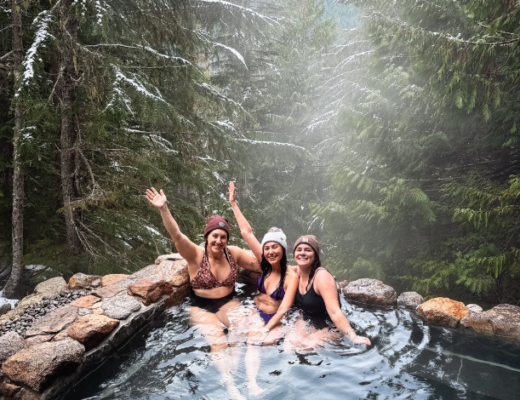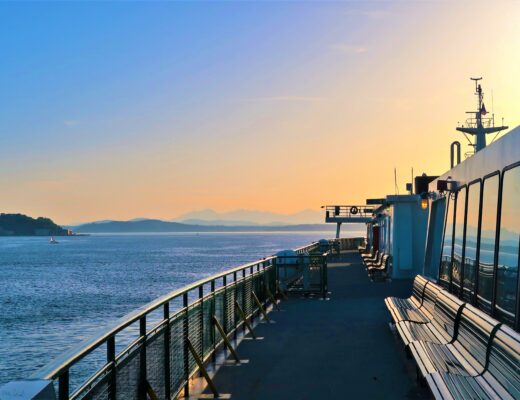Image: Inland Surfer
If you’ve visited Lake Sammamish in the summer, you know how much of a watersports lake this is. When the sun rises and the lake is a mirror, waterskiers make the rounds, sending up roostertails. As the day heats up, wakesurfers perform tricks atop frothy waves and paddleboarders skim past the end of the dock. Nothing surprising for a lake. But what is surprising is just how much the history of watersports and Lake Sammamish are intertwined.
The Invention of Early Waterskis
In the summer of 1928 after he graduated from high school, Bellevue teenager Don Ibsen—an accomplished snowskier, gymnast and swimmer—was looking for his next thrill. He attempted to ski behind motorboats on wooden boards reclaimed from boxes, and then on snow skis, Obviously, neither method worked. Then he tried a new approach: He curved 7-foot-long, 8-inch-wide cedar boards around a telephone pole and tacked tennis shoes to them, creating the first water skis in the Northwest. (The sport had reportedly begun six years earlier on the East Coast, a fact that was unknown to Ibsen at the time.)
By age 25, Ibsen was selling his homemade water skis, and in 1941 he founded the first waterski club in the nation, the Olympic Water Ski Club. Members honed their skills waterskiing on Lake Washington and Lake Sammamish—where the water is calmer, making skiing a lot easier.
No Hollow Victory
Waterskiing was still relatively unknown to the general public in the early ’60s when another teenager was tinkering with exotic woods and different shapes in his parents’ Lake Sammamish basement. Herb O’Brien was trying to come up with a waterski with greater stability. His efforts led to a revolutionary new ski with a wide, deep tunnel on the bottom. This new ski generated a wave of excitement in the watersports community and beyond. At the age of 22, O’Brien launched his namesake waterski company, which completely changed the trajectory of the sport. Waterskiing was finally accessible to all.
O’Brien skis swiftly beat out all the competition, becoming one of the 50 most-well-recognized brands in the world. The skis flew off the production line; even Ethel Kennedy placed an order for the Kennedy family.
Water Follies: In 1934, the first of many annual outboard boat races was held on the Sammamish River (or slough) that starts at the north end of the lake. Racers skidded and shimmied 13.5 miles, around 63 bends, to Lake Washington. The race was unbelievably dangerous. Boats inevitably ended up smacking into each other, landing in farm fields or worse, flipping up onto banks teeming with cheering crowds. (Tens of thousands gathered annually for the spectacle.) Not to be outdone, members of the Olympic Water Ski Club started their own slough races in 1948. The daredevils skied around hairpin bends, slalomed through piers poking out of the water and threaded through the support posts of Bothell Bridge. At a sawmill near Woodinville a logjam choked the river, leaving only a narrow channel that skiers had to zip through with only 6 feet of clearance on each side. Inevitably, tow ropes tangled, some miscalculated a turn and ended up doing somersaults on land, and one unlucky fellow in 1958 did a face plant into a bridge trestle, losing several teeth. Both madcap races came to an end in the mid-’60s.
A brilliant entrepreneur, O’Brien was used to pushing boundaries. But fame didn’t save him when he and his associates were found guilty in 1975 in a cocaine-smuggling operation out of Chile. They had been using the hollow tunnels inside O’Brien skis to hide the stash—some 200 pounds. He sold his company before heading off to prison.
Riding the Wakes
Six years in prison didn’t crush O’Brien’s spirit. Upon his release he jumped right back into the sport, starting up HO Sports on Lake Sammamish in 1981 just in time to catch the wave of interest in wakeboarding. O’Brien went into R&D mode again, and emerged with the first compression-molded, neutral-buoyancy wakeboard, the Hyperlite, which quickly became the industry standard. O’Brian’s second company was also a massive success, and over the course of 20 years HO Sports became the industry titan.
While wakeboarding continued to grow in popularity it wasn’t an easy sport, and it teetered on the edge of being dangerous. Brian notes that If you got your front edge hooked on the water you’d do a high-speed face plant, smacking your face onto the water’s surface and getting a bloody nose. “A neighbor‘s board stopped and the boat kept going, and he dislocated a hip. That was it for me,” he adds.
Surf City
A new watersports chapter arrived in the ’70s when the Page family moved to Lake Sammamish. Their teenage son, Jeff, was smitten with the idea of surfing, but living inland, there were no options. So he and his friends improvised, teaching themselves to use a longboard to surf behind boats.
Passionate about this newly imagined sport, Page figured others would love it, too, and in the ’90s he dove into designing boards that were a better size for boat wakes. Working in his garage, Page experimented with different shapes and materials, honing his design skills while creating prototypes for a California company. In 2000 he launched his own company, Inland Surfer, the first-ever wakesurf company, to bring surfing to the inland market. He sold his first production run of boards on … you guessed it, Lake Sammamish. [Today, Page is a North Rosemont neighbor.]
The development of wakesurfing led to the design of specialized boats that generated larger waves by taking on ballast (water) on one side. Once wakesurfers get their balance, they throw the rope back into the boat and surf independently on the wake. The sport is much easier to learn than waterskiing or wakeboarding.
The Competitive Edge
In 2010, Inland Surfer sponsored the first Northwest Wake Surf Open championships on Lake Sammamish, and within a few years the event drew competitors from around the world. After one of the competitions roughly a decade ago, one of the sport’s pioneering champions, French athlete Dominic Lagace, offered wake-surfing lessons to locals to cover his travel expenses. Brian was one of the lucky few chosen for this unique opportunity!
The competition on Lake Sammamish eventually gave rise to the World Wake Surfing Championship, held around the globe today.
The passion, drive, athleticism and sheer audacity of these young, eager inventors rocked the world of watersports. It’s hard to imagine today that all this took place right here on the shores and waters of Lake Sammamish.




